Influence of Non-Thermal Plasma on the Quality and Nutritional Content of Palm Dates
Abstract
:1. Introduction
2. Experimental Setup
2.1. Plasma System
2.2. Sample Collection for Fungi Inhibition Using SDBD
2.3. Isolation and Identification of Fungi Associated with Dates
2.4. Sample Collection for Palm Dates Treatment Using SDBD
2.5. Physicochemical Measurements
2.6. Statistical Analysis
3. Results and Discussion
3.1. Plasma Diagnostics
3.2. Inhibition of A. niger Using SDBD Plasma
3.3. Total Phenolic
3.4. The Antioxidant
3.5. HMF
3.6. Chemical Compositions
3.7. Water Soluble Vitamins
3.8. Amino Acids
3.9. Minerals
3.10. Principal Component Analysis
4. Conclusions
Author Contributions
Funding
Institutional Review Board Statement
Informed Consent Statement
Data Availability Statement
Acknowledgments
Conflicts of Interest
References
- Fernández, A.; Shearer, N.; Wilson, D.R.; Thompson, A. Effect of microbial loading on the efficiency of cold atmospheric gas plasma inactivation of Salmonella enterica serovar Typhimurium. Int. J. Food Microbiol. 2012, 152, 175–180. [Google Scholar] [CrossRef] [PubMed]
- Jayasena, D.D.; Kim, H.J.; Yong, H.I.; Park, S.; Kim, K.; Choe, W.; Jo, C. Flexible thin-layer dielectric barrier discharge plasma treatment of pork butt and beef loin: Effects on pathogen inactivation and meat-quality attributes. Food Microbiol. 2015, 46, 51–57. [Google Scholar] [CrossRef] [PubMed]
- Kim, J.S.; Lee, E.J.; Choi, E.H.; Kim, Y.J. Inactivation of Staphylococcus aureus on the beef jerky by radio-frequency atmospheric pressure plasma discharge treatment. Innov. Food Sci. Emerg. Technol. 2014, 22, 124–130. [Google Scholar] [CrossRef]
- Jimenez-Sanchez, C.; Lozano-Sanchez, J.; Segura-Carretero, A.; Fernandez-Gutierrez, A. Alternatives to conventional thermal treatments in fruit-juice processing. Part 2: Effect on composition, phytochemical content, and physicochemical, rheological, and organoleptic properties of fruit juices. Crit. Rev. Food Sci. Nutr. 2017, 57, 637–652. [Google Scholar] [CrossRef]
- Waghmare, R. Cold plasma technology for fruit based beverages: A review. Trends Food Sci. Technol. 2021, 114, 60–69. [Google Scholar] [CrossRef]
- Silva, R.M.; Campelo, P.H.; Silva, F.E.F.; Zampieri, D.S.; Gramosa, N.V.; Fernandes, F.A.; Rodrigues, S. NMR Spectroscopy and Chemometrics to Evaluate the Effect of Different Non-Thermal Plasma Processing on Sapota-do-Solimões (Quararibea cordata Vischer) Juice Quality and Composition. Food Bioprocess Technol. 2022, 15, 875–890. [Google Scholar] [CrossRef]
- Pohl, P.; Dzimitrowicz, A.; Cyganowski, P.; Jamroz, P. Do we need cold plasma treated fruit and vegetable juices? A case study of positive and negative changes occurred in these daily beverages. Food Chem. 2022, 375, 131831. [Google Scholar] [CrossRef]
- Wu, Y.; Cheng, J.H.; Sun, D.W. Blocking and degradation of aflatoxins by cold plasma treatments: Applications and mechanisms. Trends Food Sci. Technol. 2021, 109, 647–661. [Google Scholar] [CrossRef]
- Castro, D.R.G.; Mar, J.M.; da Silva, L.S.; da Silva, K.A.; Sanches, E.A.; de Araujo Bezerra, J.; Rodriguese, S.; Fernandesf, F.A.N.; Campeloab, P.H. Dielectric barrier atmospheric cold plasma applied on camu-camu juice processing: Effect of the excitation frequency. Food Res. Int. 2020, 131, 109044. [Google Scholar] [CrossRef]
- Starek, A.; Sagan, A.; Andrejko, D.; Chudzik, B.; Kobus, Z.; Kwiatkowski, M.; Terebun, P.; Pawłat, J. Possibility to extend the shelf life of NFC tomato juice using cold atmospheric pressure plasma. Sci. Rep. 2020, 10, 20959. [Google Scholar] [CrossRef]
- Campelo, P.H.; Alves Filho, E.G.; Silva, L.M.A.; de Brito, E.S.; Rodrigues, S.; Fernandes, F.A.N. Modulation of aroma and flavor using glow discharge plasma technology. Innov. Food Sci. Emerg. Technol. 2020, 62, 102363. [Google Scholar] [CrossRef]
- Barbosa-Cánovas, G.V.; Donsì, F.; Yildiz, S.; Candoğan, K.; Pokhrel, P.R.; Guadarrama-Lezama, A.Y. Nonthermal processing technologies for stabilization and enhancement of bioactive compounds in foods. Food Eng. Rev. 2022, 14, 63–99. [Google Scholar] [CrossRef]
- Muhammad, A.I.; Liao, X.; Cullen, P.J.; Liu, D.; Xiang, Q.; Wang, J.; Chen, S.; Ye, X.; Ding, T. Effects of nonthermal plasma technology on functional food components. Compr. Rev. Food Sci. Food Saf. 2018, 17, 1379–1394. [Google Scholar] [CrossRef]
- Tappi, S.; Ragni, L.; Tylewicz, U.; Romani, S.; Ramazzina, I.; Rocculi, P. Browning response of fresh-cut apples of different cultivars to cold gas plasma treatment. Innov. Food Sci. Emerg. Technol. 2019, 53, 56–62. [Google Scholar] [CrossRef]
- Ganesan, A.R.; Tiwari, U.; Ezhilarasi, P.N.; Rajauria, G. Application of cold plasma on food matrices: A review on current and future prospects. J. Food Process. Preserv. 2021, 45, e15070. [Google Scholar] [CrossRef]
- Tang, Z.X.; Shi, L.E.; Aleid, S.M. Date fruit: Chemical composition, nutritional and medicinal values, products. J. Sci. Food Agric. 2013, 9, 2351–2361. [Google Scholar] [CrossRef]
- Al-Ahmadi, S.S.; Ibrahim, R.H.; Ouf, S.A. Application of ozone to control insect pests and moulds of date fruits. Biosci. Biotechnol. Res. Asia 2009, 6, 435–446. [Google Scholar] [CrossRef]
- Ouf, S.A.; Basher, A.H.; Mohamed, A.A.H. Inhibitory effect of double atmospheric pressure argon cold plasma on spores and mycotoxin production of Aspergillus niger contaminating date palm fruits. J. Sci. Food Agric. 2015, 95, 3204–3210. [Google Scholar] [CrossRef]
- Dasan, B.G.; Mutlu, M.; Boyaci, I.H. Decontamination of Aspergillus flavus and Aspergillus parasiticus spores on hazelnuts via atmospheric pressure fluidized bed plasma reactor. Int. J. Food Microbiol. 2016, 216, 50–59. [Google Scholar] [CrossRef]
- Biganzoli, I.; Barni, R.; Riccardi, C. Note: On the use of Rogowski coils as current probes for atmospheric pressure dielectric barrier discharges. Rev. Sci. Instrum. 2013, 84, 016101. [Google Scholar] [CrossRef]
- Piferi, C.; Riccardi, C. A study on propane depletion by surface dielectric barrier discharges. Clean. Eng. Technol. 2022, 8, 100486. [Google Scholar] [CrossRef]
- Piferi, C.; Brescia, A.; Riccardi, C. Intensity comparison between UV lamps and plasma emission for air purification studies. AIP Adv. 2021, 11, 085209. [Google Scholar] [CrossRef]
- Pitt, J.I.; Hocking, A.D. Fungi and Food Spoilage; Acadamic Press: Sydney, Australia, 1985; pp. 1–413. [Google Scholar]
- Raper, K.B.; Fennell, D.J. The Genus Aspergillus; Williams and Wikins: Baltimore, MA, USA, 1965. [Google Scholar]
- Klich, M.A. Identifiction of Common Aspergillus Species; United State Department of Agriculture, Agriculutre Research Service, Southern Regional Research Center: New Oluisiana, LA, USA, 2002; p. 116. [Google Scholar]
- Muranyi, P.; Wunderlich, J.; Heise, M. Sterilization efficiency of a cascaded dielectric barrier discharge. J. Appl. Microbiol. 2007, 103, 1535–1544. [Google Scholar] [CrossRef] [PubMed]
- Association of Official Analytical Chemists International. AOAC Official Methods of Analysis, 18th ed.; AOAC: Gaithersburg, Maryland, 2012. [Google Scholar]
- Association of Official Analytical Chemists International. Official Method of Analysis Association of Official Analytical Chemists, 15th ed.; AOAC International Publisher: Washington, DC, USA, 1990. [Google Scholar]
- James, C.S. Experimental Methods. In Analytical Chemistry of Foods; Champman and Hall: New York, NY, USA, 1995; p. 28. [Google Scholar] [CrossRef]
- Miller, G.L. Use of dinitrosalicylic acid reagent for determination of reducing sugar. Anal. Chem. 1959, 31, 426–428. [Google Scholar] [CrossRef]
- Jajic, I.; Krstovic, S.; Glamocis, D.; Jaksis, S.; Abramovic, B. Validation of an HPLC method for the determination of amino acids in feed. J. Serb. Chem. Soc. 2013, 78, 839–850. [Google Scholar] [CrossRef]
- Cheng, K.L.; Bray, R.H. Determination of Calcium and Magnesium in Soil and Plants materials. Soil Sci. 1951, 72, 449–458. [Google Scholar] [CrossRef]
- Kundsen, D.; Peterson, G.A.; Pratt, P.F. Lithium, Sodium and Potassium. In Methods of Soil Analysis; Page, A.L., Miller, R.H., Keeney, D.R., Eds.; part 2. Agron. Monogr. 9; American Society of Agronomy: Madison, WI, USA, 1982; pp. 225–246. [Google Scholar]
- Walter, W.G. Standard Methods for the Examination of Water and Wastewater; American Public Health Association: Washington, DC, USA, 1989; p. 940. [Google Scholar]
- Raofie, F.; Falsafi, Z. Development of a bimetal–organic framework–polypyrrole composite as a novel fiber coating for direct immersion solid phase microextraction in situ supercritical fluid extraction coupled with gas chromatography for simultaneous determination of furfurals in dates. Anal. Methods 2021, 13, 4941–4948. [Google Scholar]
- Sun, J.; Chu, Y.F.; Wu, X.; Liu, R.H. Antioxidant and antiproliferative activities of common fruits. J. Agric. Food Chem. 2022, 50, 7449–7454. [Google Scholar] [CrossRef]
- Zhu, X.B.; Pan, L.; Wei, W.; Pen, J.-Q.; Qi, Y.-W.; Ren, X.-L. Changes in the content of water-soluble vitamins in Actinidia chinensis during cold storage. J. Serb. Chem. Soc. 2016, 81, 623–632. [Google Scholar] [CrossRef]
- Ilahi, I.; Samar, S.; Khan, I.; Ahmad, I. In vitro antioxidant activities of four medicinal plants on the basis of DPPH free radical scavenging. Pk. J. Pharm. Sci. 2013, 26, 949–952. [Google Scholar]
- Kogelschatz, U.; Eliasson, B.; Egli, W. From ozone generators to flat television screens: History and future potential of dielectric-barrier discharges. Pure Appl. Chem. 1999, 71, 1819–1828. [Google Scholar] [CrossRef]
- Goldberg, B.M.; Hoder, T.; Brandenburg, R. Electric field determination in transient plasmas: In-situ & non-invasive methods. Plasma Sources Sci. Technol. 2022.
- Šimek, M.; Homola, T. Plasma-assisted agriculture: History, presence, and prospects—A review. Eur. Phys. J. D 2021, 75, 210. [Google Scholar] [CrossRef]
- Massines, F.; Rabehi, A.; Decomps, P.; Gadri, R.B.; Ségur, P.; Mayoux, C. Experimental and theoretical study of a glow discharge at atmospheric pressure controlled by dielectric barrier. J. Appl. Phys. 1998, 83, 2950–2957. [Google Scholar] [CrossRef]
- Škoro, N.; Živković, S.; Jevremović, S.; Puač, N. Treatment of Chrysanthemum Synthetic Seeds by Air SDBD Plasma. Plants 2022, 11, 907. [Google Scholar] [CrossRef]
- Misra, N.N.; Keener, K.M.; Bourke, P.; Cullen, P.J. Generation of in-package cold plasma and efficacy assessment using methylene blue. Plasma Chem. Plasma Process. 2015, 35, 1043–1056. [Google Scholar] [CrossRef]
- Imlay, J.A. The molecular mechanisms and physiological consequences of oxidative stress: Lessons from a model bacterium. Nat. Rev. Microbiol. 2013, 11, 443–454. [Google Scholar] [CrossRef]
- Mai-Prochnow, A.; Murphy, A.B.; McLean, K.M.; Kong, M.G.; Ostrikov, K. Atmospheric pressure plasmas: Infection control and bacterial responses. Int. J. Antimicrob. Agents 2014, 43, 508–517. [Google Scholar] [CrossRef]
- Kiš, M.; Milošević, S.; Vulić, A.; Herceg, Z.; Vukušić, T.; Pleadin, J. Efficacy of low pressure DBD plasma in the reduction of T-2 and HT-2 toxin in oat flour. Food Chem. 2020, 316, 126372. [Google Scholar] [CrossRef]
- Muranyi, P.; Wunderlich, J.; Heise, M. Influence of relative gas humidity on the inactivation efficiency of a low temperature gas plasma. J. Appl. Microbiol. 2008, 104, 1659–1666. [Google Scholar] [CrossRef]
- Xu, D.; Luo, X.; Xu, Y.; Cui, Q.; Yang, Y.; Liu, D.; Chen, H.; Kong, M.G. The effects of cold atmospheric plasma on cell adhesion, differentiation, migration, apoptosis and drug sensitivity of multiple myeloma. Biochem. Biophys. Res. Comm. 2016, 473, 1125–1132. [Google Scholar] [CrossRef] [PubMed]
- Xiong, Z.; Du, T.; Lu, X.; Cao, Y.; Pan, Y. How deep can plasma penetrate into a biofilm? Appl. Phys. Lett. 2011, 98, 221503. [Google Scholar] [CrossRef]
- Pasquali, F.; Stratakos, A.C.; Koidis, A.; Berardinelli, A.; Cevoli, C.; Ragni, L.; Mancusic, R.; Manfredaa, G.; Trevisanic, M. Atmospheric cold plasma process for vegetable leaf decontamination: A feasibility study on radicchio (red chicory, Cichorium intybus L.). Food Control 2016, 60, 552–559. [Google Scholar] [CrossRef]
- Ambrico, P.F.; Šimek, M.; Rotolo, C.; Morano, M.; Minafra, A.; Ambrico, M.; Pollastro, S.; Gerin, D.; Faretra, F.; De Miccolis Angelini, R.M. Surface Dielectric Barrier Discharge plasma: A suitable measure against fungal plant pathogens. Sci. Rep. 2020, 10, 3673. [Google Scholar] [CrossRef]
- Kuzminova, A.; Kretková, T.; Kylián, O.; Hanuš, J.; Khalakhan, I.; Prukner, V.; Biederman, H. Etching of polymers, proteins and bacterial spores by atmospheric pressure DBD plasma in air. J. Phys. D Appl. Phys. 2017, 50, 135201. [Google Scholar] [CrossRef]
- Won, M.Y.; Lee, S.J.; Min, S.C. Mandarin Preservation by Microwave-Powered Cold wPlasma Treatment. Innov. Food Sci. Emerg. Technol. 2017, 39, 25–32. [Google Scholar] [CrossRef]
- Li, M.; Li, X.; Han, C.; Ji, N.; Jin, P.; Zheng, Y. Physiological and metabolomic analysis of cold plasma treated fresh-cut strawberries. J. Agric. Food Chem. 2019, 67, 4043–4053. [Google Scholar] [CrossRef]
- Li, X.; Li, M.; Ji, N.; Jin, P.; Zhang, J.; Zheng, Y.; Zhang, X.; Li, F. Cold plasma treatment induces phenolic accumulation and enhances antioxidant activity in fresh-cut pitaya (Hylocereus undatus) fruit. Lwt 2019, 115, 108447. [Google Scholar] [CrossRef]
- Sarangapani, C.; O’Toole, G.; Cullen, P.J.; Bourke, P. Atmospheric cold plasma dissipation efficiency of agrochemicals on blueberries. Innov. Food Sci. Emerg. Technol. 2017, 44, 235–241. [Google Scholar] [CrossRef]
- Hou, Y.; Wang, R.; Gan, Z.; Shao, T.; Zhang, X.; He, M.; Sun, A. Effect of cold plasma on blueberry juice quality. Food Chem. 2019, 290, 79–86. [Google Scholar] [CrossRef]
- Herceg, Z.; Kovacevic, D.B.; Kljusuric, J.G.; Jambrak, A.R.; Zoric, Z.; Dragovic-Uzelac, V. Gas phase plasma impact on phenolic compounds in pomegranate juice. Food Chem. 2016, 190, 665–672. [Google Scholar] [CrossRef] [PubMed]
- Bao, T.; Hao, X.; Shishir, M.R.I.; Karim, N.; Chen, W. Cold plasma: An emerging pretreatment technology for the drying of jujube slices. Food Chem. 2021, 337, 127783. [Google Scholar] [CrossRef] [PubMed]
- Paixao, L.M.N.; Fonteles, T.V.; Oliveira, V.S.; Fernandes, F.A.N.; Rodrigues, S. Cold plasma effects on functional compounds of siriguela juice. Food Bioprocess Technol. 2019, 12, 110–121. [Google Scholar] [CrossRef]
- Chen, Y.Q.; Cheng, J.H.; Sun, D.W. Chemical, physical and physiological quality attributes of fruit and vegetables induced by cold plasma treatment: Mechanisms and application advances. Crit. Rev. Food Sci. Nutr. 2020, 60, 2676–2690. [Google Scholar] [CrossRef]
- Berardinelli, A.; Vannini, L.; Ragni, L.; Guerzoni, M.E. Impact of Atmospheric Plasma Generated by a DBD Device on Quality-Related Attributes of “Abate Fetel” Pear Fruit Plasma for Bio-Decontamination, Medicine and Food Security; Springer: Berlin/Heidelberg, Germany, 2012. [Google Scholar]
- Bogdanov, T.; Tsonev, I.; Marinova, P.; Benova, E.; Rusanov, K.; Rusanova, M.; Atanassov, I.; Kozáková, Z.; Krčma, F. Microwave plasma torch generated in argon for small berries surface treatment. Appl. Sci. 2018, 8, 1870. [Google Scholar] [CrossRef]
- Ziuzina, D.; Misra, N.; Han, L.; Cullen, P.; Moiseev, T.; Mosnier, J.; Keener, K.; Gastone, E.; Vilaró, I.; Bourke, P. Investigation of a large gap cold plasma reactor for continuous in-package decontamination of fresh strawberries and spinach. Innov. Food Sci. Emerg. Technol. 2020, 59, 102229. [Google Scholar] [CrossRef]
- Pour, A.K.; Khorram, S.; Ehsani, A.; Ostadrahimi, A.; Ghasempour, Z. Atmospheric cold plasma effect on quality attributes of banana slices: Its potential use in blanching process. Innov. Food Sci. Emerg. Technol. 2022, 76, 102945. [Google Scholar] [CrossRef]
- Illera, A.E.; Chaple, S.; Sanz, M.T.; Ng, S.; Lu, P.; Jones, J.; Bourke, P. Effect of cold plasma on polyphenol oxidase inactivation in cloudy apple juice and on the quality parameters of the juice during storage. Food Chem. 2019, 3, 100049. [Google Scholar] [CrossRef]
- Bao, Y.; Reddivari, L.; Huang, J.-Y. Development of cold plasma pretreatment for improving phenolics extractability from tomato pomace. Innov. Food Sci. Emerg. Technol. 2020, 65, 102445. [Google Scholar] [CrossRef]
- Bastos, D.M.; Monaro, E.; Siguemoto, E.; Séfora, M. Maillard Reaction Products in Processed Food: Pros and Cons; IntechOpen: London, UK, 2012. [Google Scholar] [CrossRef]
- Shapla, U.M.; Solayman, M.; Alam, N.; Khalil, M.; Gan, S.H. 5-Hydroxymethylfurfural (HMF) levels in honey and other food products: Effects on bees and human health. Chem. Cent. J. 2018, 12, 35. [Google Scholar] [CrossRef]
- Onal-Ulusoy, B. Effects of Cold Atmospheric Gliding Arc Discharge Plasma, Non-thermal Ultrasound, and Low-Temperature Oven Treatments on Quality Parameters of Turkish Blossom Honey. Food Bioprocess Technol. 2021, 14, 1763–1771. [Google Scholar] [CrossRef]
- Trivedi, M.H.; Patel, K.; Itokazu, H.; Huynh, N.A.; Kovalenko, M.; Nirenberg, G.; Miller, V.; Fridman, A.; Fridman, G.; Lahne, J.; et al. Enhancing shelf life of bananas by using atmospheric pressure pulsed cold plasma treatment of the storage atmosphere. Plasma Med. 2019, 9, 23–38. [Google Scholar] [CrossRef]
- Zhao, N.; Ge, L.; Huang, Y.; Wang, Y.; Wang, Y.; Lai, H.; Wang, Y.; Zhu, Y.; Zhang, J. Impact of cold plasma processing on quality parameters of packaged fermented vegetable (radish paocai) in comparison with pasteurization processing: Insight into safety and storage stability of products. Innov. Food Sci. Emerg. Technol. 2020, 60, 102300. [Google Scholar] [CrossRef]
- Dong, X.Y.; Yang, Y.L. A novel approach to enhance blueberry quality during storage using cold plasma at atmospheric air pressure. Food Bioprocess Technol. 2019, 12, 1409–1421. [Google Scholar] [CrossRef]
- Suhem, K.; Matan, N.; Nisoa, M.; Matan, N. Low pressure RF plasma effects on the mould control, physical quality, nutritional value, mineral content and trace element content of a brown rice snack bar. J. Food Nutr. Res. 2013, 52, 87–94. [Google Scholar]
- Zhou, R.; Zhou, R.; Yu, F.; Xi, D.; Wang, P.; Li, J.; Wang, X.; Zhang, X.; Bazak, K.; Ostrikov, K.K. Removal of organophosphorus pesticide residues from Lycium barbarum by gas phase surface discharge plasma. Chem. Eng. J. 2018, 342, 401–409. [Google Scholar] [CrossRef]
- Nowicka, P.; Wojdyło, A.; Laskowski, P. Principal component analysis (PCA) of physicochemical compounds’ content in different cultivars of peach fruits, including qualification and quantification of sugars and organic acids by HPLC. Eur. Food Res. Technol. 2019, 245, 929–938. [Google Scholar] [CrossRef]
- Abdul-Hamid, N.A.; Mustaffer, N.H.; Maulidiani, M.; Mediani, A.; Ismail, I.S.; Tham, C.L.; Shadid, K.; Abas, F. Quality evaluation of the physical properties, phytochemicals, biological activities and proximate analysis of nine Saudi date palm fruit varieties. J. Saudi Soc. Agric. Sci. 2020, 19, 151–160. [Google Scholar] [CrossRef]
- Elsafy, M.; Gustavsson, L.G.; Mujaju, C. Phenotypic diversity of date palm cultivars (Phoenix dactylifera L.) from sudan estimated by vegetative and fruit characteristics. Int. J. Biodivers. 2015, 2015, 610391. [Google Scholar] [CrossRef]
- Diboun, I.; Mathew, S.; Al-Rayyashi, M.; Elrayess, M.; Torres, M.; Halama, A.; Méret, M.; Mohney, R.P.; Karoly, E.D.; Malek, J.; et al. Metabolomics of dates (Phoenix dactylifera) reveals a highly dynamic ripening process accounting for major variation in fruit composition. BMC Plant Bio. 2015, 15, 291. [Google Scholar] [CrossRef]
- Badarusham, K.; Sabri, N.E.; Salvamani, S.; Hassan, M.S.; Hassan, Z.; Hashim, R. Assessment of Minerals in Phoenix dactylifera L. as Determined by Inductively Coupled Plasma Optical Emission Spectrometry using ANOVA and PCA. Int. J. Recent Technol. Eng. 2019, 8, 336–344. [Google Scholar] [CrossRef]
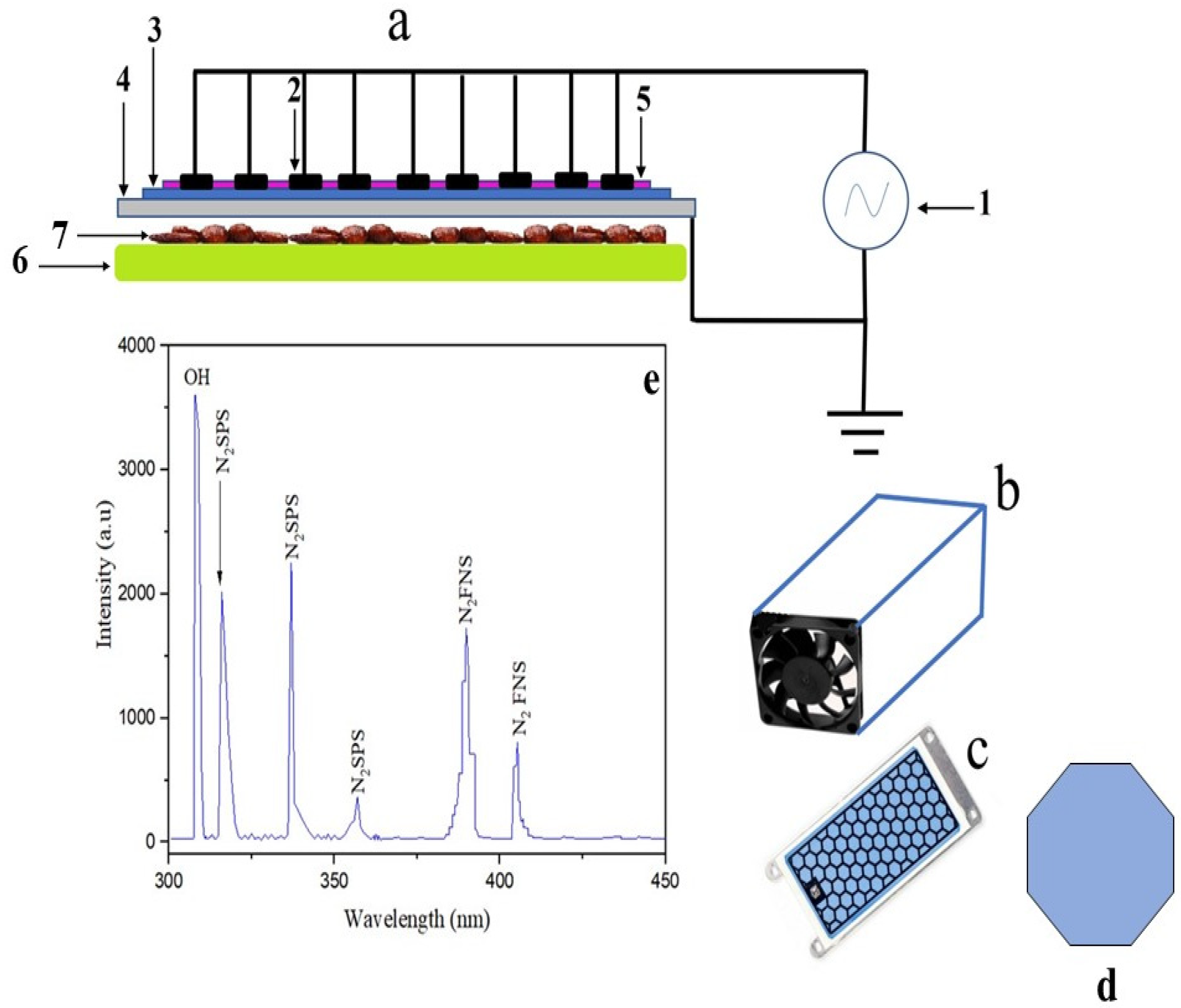
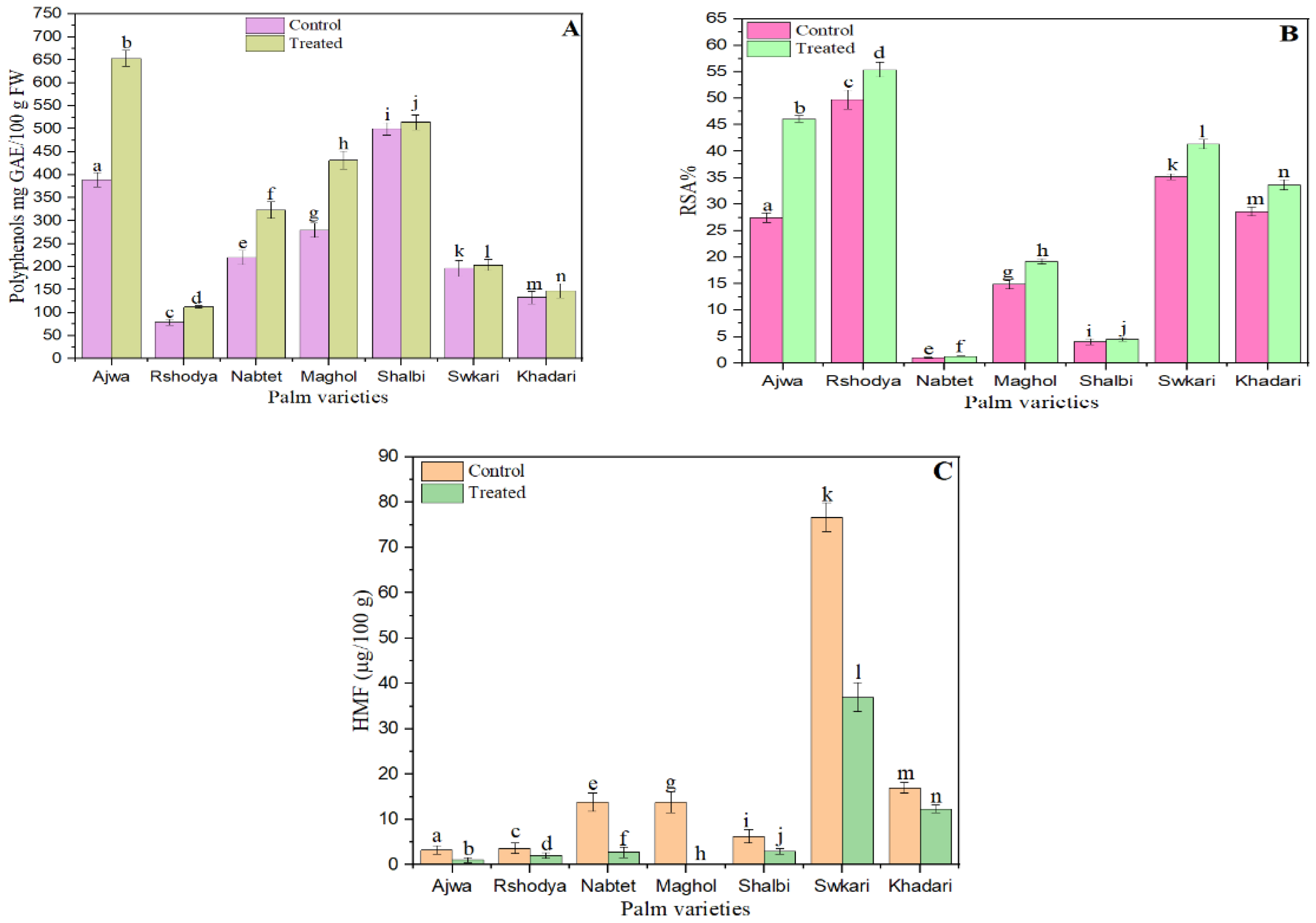
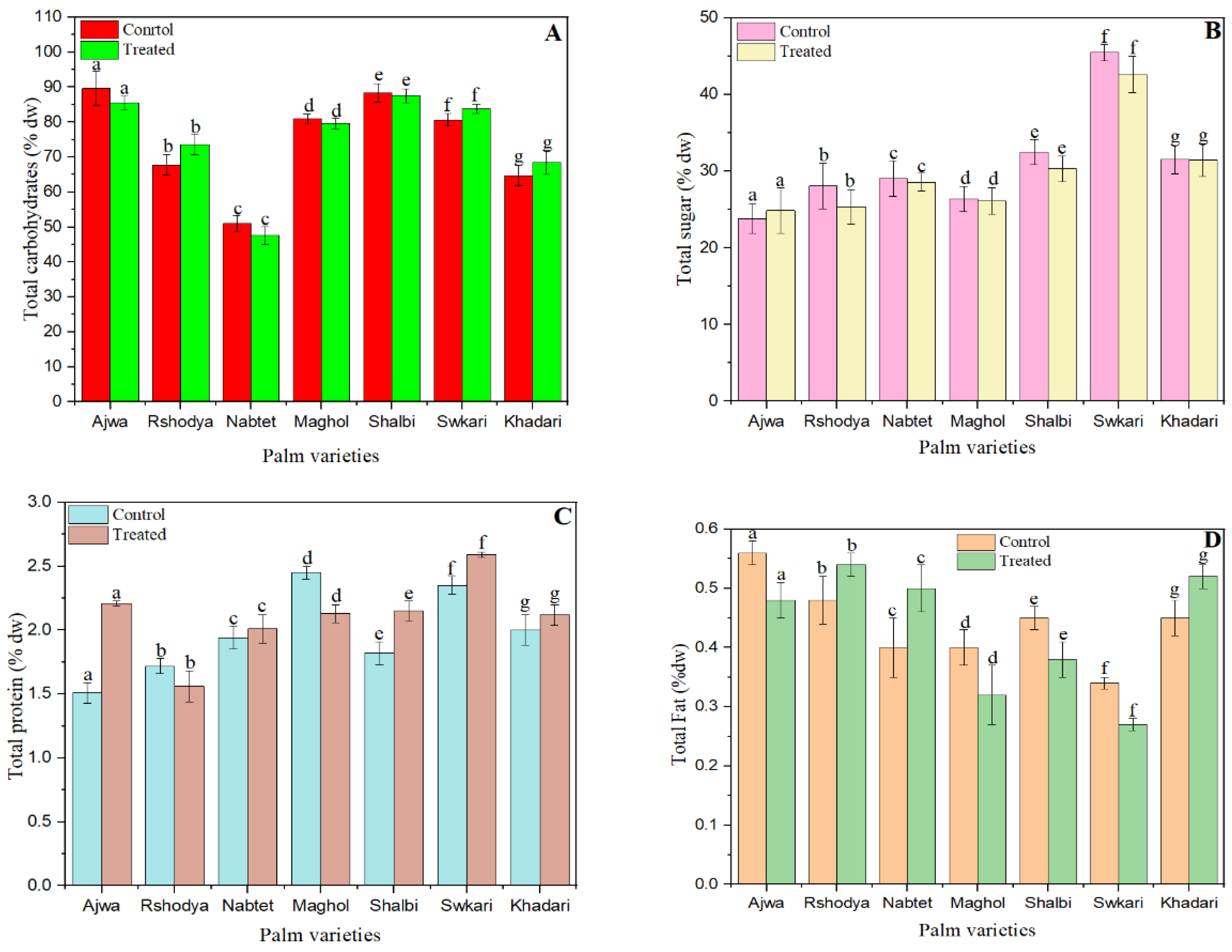
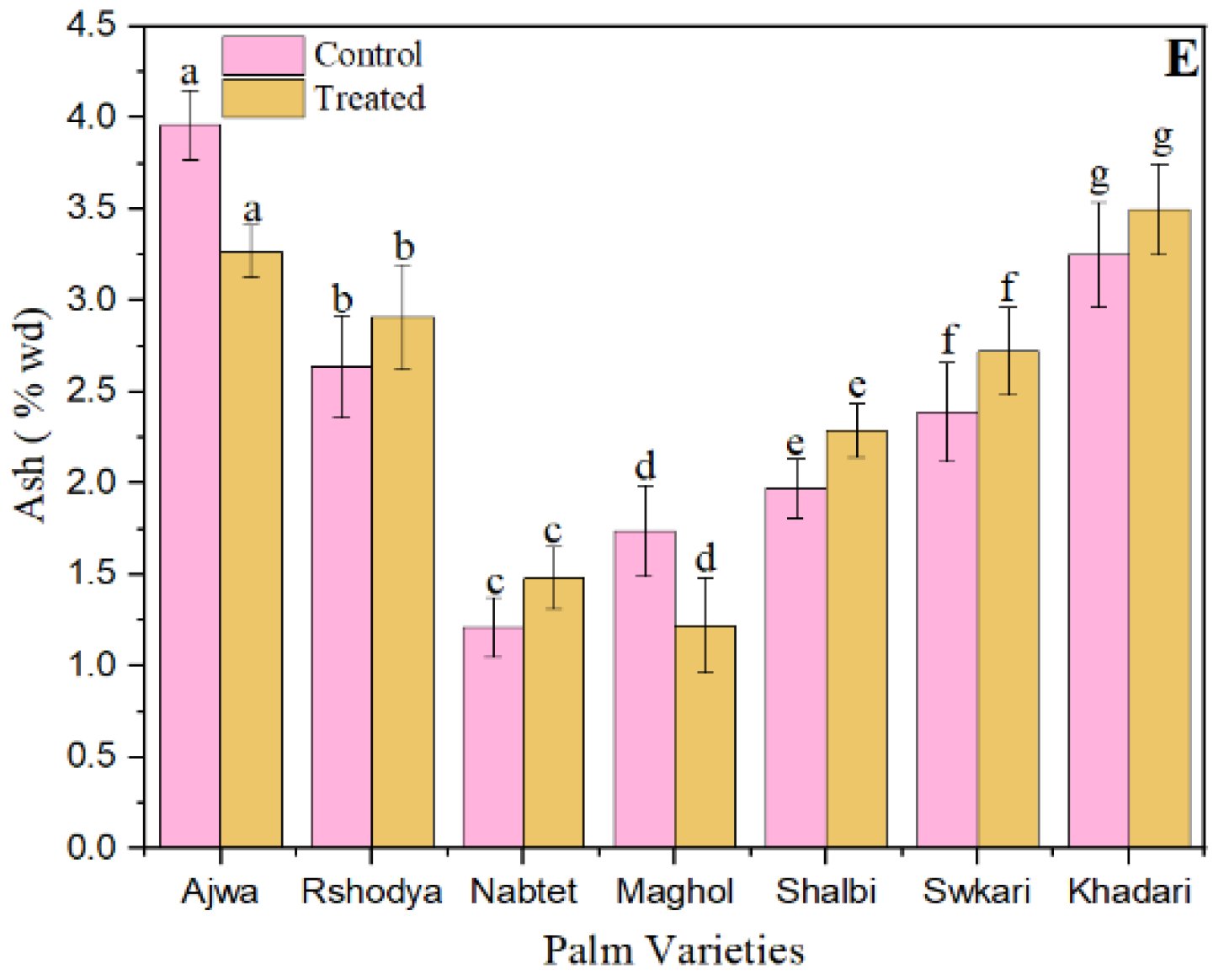
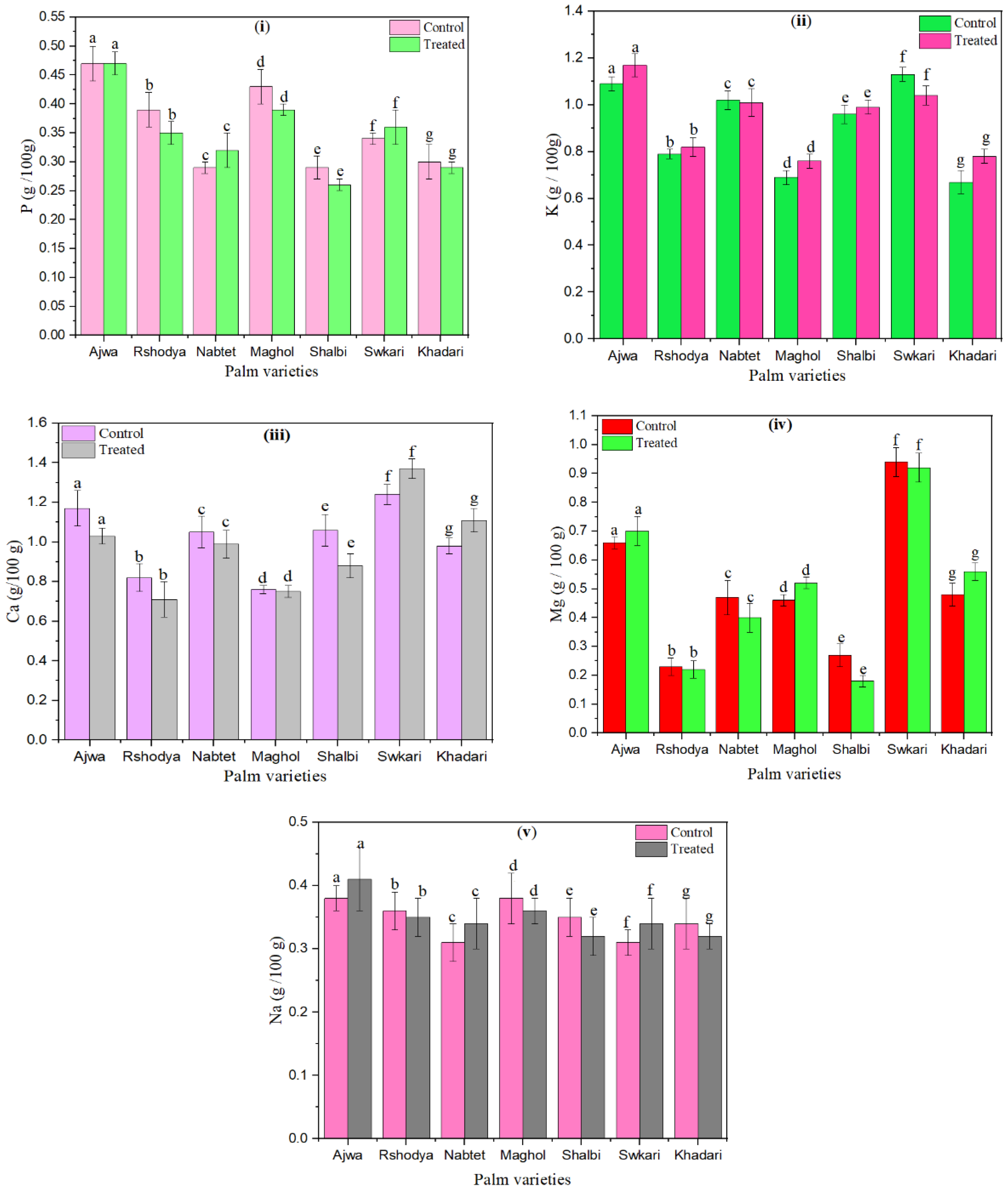
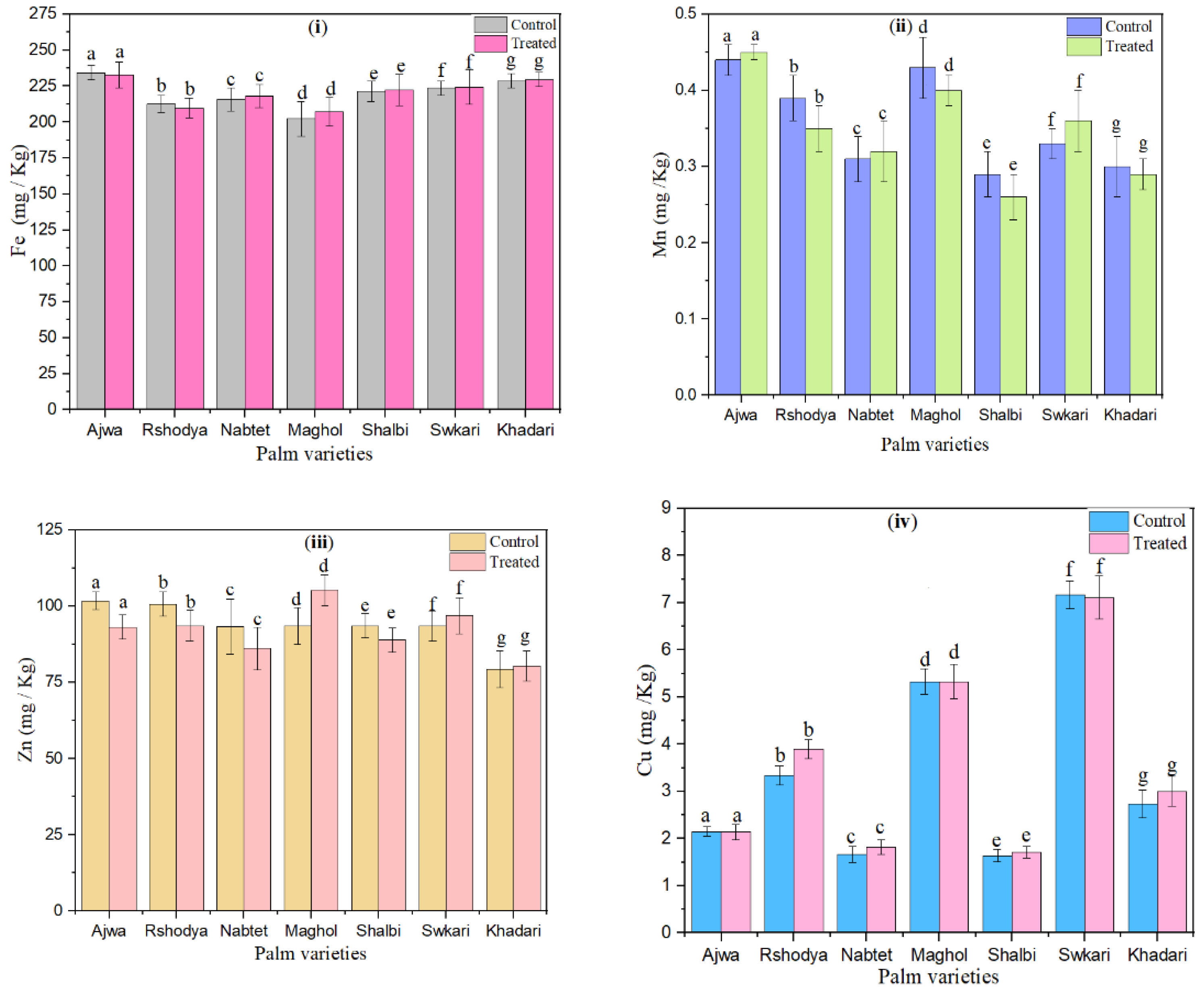
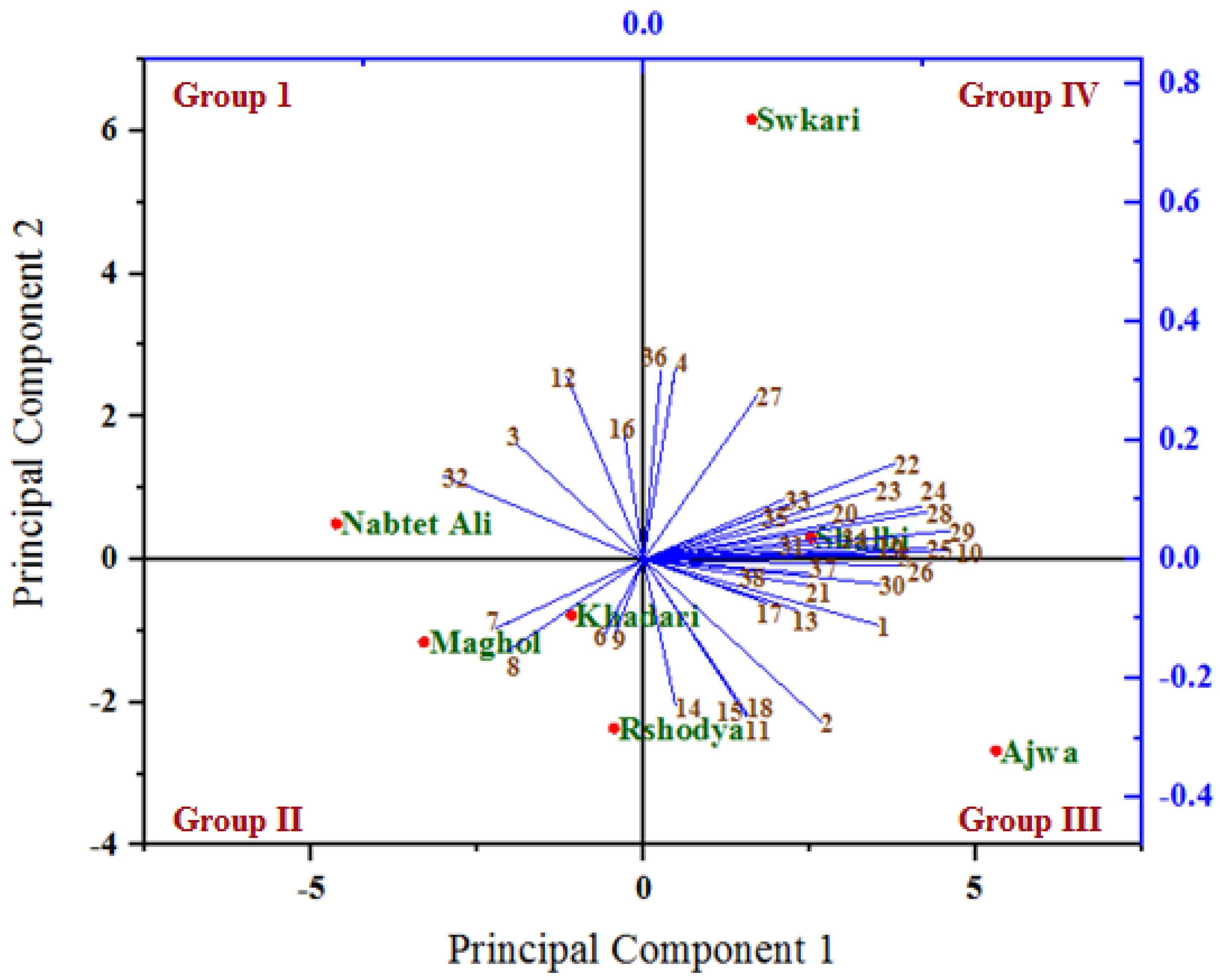

| Treatment Time (min) | A. Niger Spore Log (CFU/g) | ||
|---|---|---|---|
| After 15 Days of Incubation | After 16 Days of Incubation | After 17 Days of Incubation | |
| 0.00 | 4.33 ± 0.09 | 4.47 ± 0.03 | 4.50 ± 0.01 |
| 1.00 | 2.50 ± 0.29 | 2.77 ± 0.23 | 2.80 ± 0.06 |
| 1.50 | 2.20 ± 0.82 | 2.43 ± 0.85 | 2.63 ± 0.81 |
| 2.00 | 1.83 ± 0.22 | 2.03 ± 0.18 | 2.37 ± 0.19 |
| 2.50 | 0.87 ± 0.57 | 0.93 ± 0.63 | 1.03 ± 0.73 |
| 3.00 | 0.33 ± 0.03 | 0.33 ± 0.03 | 0.33 ± 0.03 |
| Palm Varieties | B1 | B2 | B6 | B9 | B12 | |||||
|---|---|---|---|---|---|---|---|---|---|---|
| Control | Treatment | Control | Treatment | Control | Treatment | Control | Treatment | Control | Treatment | |
| Ajwa | 1014.22 ± 4.22 | 987.76 ± 3.99 | 130.74 ± 1.46 | 124.12 ± 2.31 | 2761.20 ± 30.96 | 2778.07 ± 21.93 | 35.39 ± 2.21 | 41.08 ± 1.16 | 372.26 ± 7.81 | 366.92 ± 6.54 |
| Rshodya | 752.84 ± 3.60 | 788.94 ± 5.51 | 894.87 ± 3.00 | 916.64 ± 3.32 | 9235.35 ± 32.37 | 9548.87 ± 28.89 | 240.63 ± 2.40 | 238.52 ± 1.25 | 585.56 ± 8.02 | 553.46 ± 8.72 |
| Nabtet Ali | 170.00 ± 2.89 | 174.08 ± 4.61 | 85.95 ± 3.74 | 74.08 ± 2.89 | 2301.66 ± 59.61 | 2317.68 ± 39.02 | 47.77 ± 2.12 | 52.36 ± 2.05 | 432.14 ± 7.70 | 441.77 ± 7.25 |
| Maghol | 512.46 ± 9.00 | 548.33 ± 4.41 | 711.51 ± 5.05 | 729.05 ± 4.97 | 9588.19 ± 47.88 | 9549.32 ± 28.88 | 226.11 ± 3.09 | 221.99 ± 3.06 | 178.16 ± 9.22 | 173.80 ± 9.26 |
| Shalbi | 990.00 ± 5.77 | 972.55 ± 6.65 | 725.82 ± 3.00 | 715.91 ± 2.15 | 2532.54 ± 66.27 | 2414.40 ± 70.58 | 37.79 ± 0.91 | 36.79 ± 0.98 | 173.08 ± 8.58 | 161.11 ± 5.88 |
| Swkari | 873.48 ± 8.96 | 830.00 ± 5.77 | 125.53 ± 3.36 | 120.11 ± 4.53 | 2728.98 ± 84.09 | 2742.02 ± 96.44 | 74.66 ± 0.88 | 76.61 ± 1.45 | 257.26 ± 9.28 | 255.20 ± 8.66 |
| Khadari | 573.33 ± 12.02 | 535.00 ± 8.66 | 228.67 ± 5.21 | 253.67 ± 7.54 | 6698.33 ± 82.28 | 6750.00 ± 28.87 | 153.67 ± 1.86 | 140.67 ± 1.76 | 314.33 ± 3.48 | 320.00 ± 2.89 |
| (a) | ||||||||||||||||
|---|---|---|---|---|---|---|---|---|---|---|---|---|---|---|---|---|
| Palm Varieties | Alanine | Arginine | Histidine | IsoLeucine | Lysine | Methionine | Proline | Serine | ||||||||
| Control | Treatment | Control | Treatment | Control | Treatment | Control | Treatment | Control | Treatment | Control | Treatment | Control | Treatment | Control | Treatment | |
| Ajwa | 18.20 ± 0.61 | 17.14 ± 0.59 | 26.22 ± 2.32 | 22.26 ± 2.33 | 2.71 ± 0.01 | 3.12 ± 0.06 | 22.93 ± 1.73 | 19.42 ± 2.02 | 14.96 ± 1.16 | 17.64 ± 2.03 | 42.74 ± 2.40 | 44.06 ± 1.49 | 24.28 ± 0.64 | 32.85 ± 0.93 | 29.61 ± 3.18 | 34.59 ± 2.95 |
| Rshodya | 10.22 ± 0.62 | 17.18 ± 0.60 | 18.26 ± 3.18 | 25.38 ± 2.91 | 2.23 ± 0.03 | 2.82 ± 0.04 | 18.43 ± 2.02 | 22.63 ± 1.43 | 9.84 ± 2.31 | 14.21 ± 2.89 | 39.77 ± 2.90 | 43.39 ± 2.21 | 13.40 ± 0.87 | 9.59 ± 0.87 | 15.23 ± 2.90 | 25.57 ± 2.94 |
| Nabtet Ali | 16.09 ± 0.58 | 18.31 ± 0.66 | 15.06 ± 2.89 | 20.11 ± 2.31 | 1.60 ± 0.06 | 1.83 ± 0.01 | 15.84 ± 1.17 | 16.68 ± 1.20 | 9.98 ± 1.01 | 13.34 ± 0.88 | 30.60 ± 1.83 | 32.85 ± 0.93 | 13.57 ± 0.87 | 12.24 ± 0.63 | 19.61 ± 2.02 | 23.49 ± 3.33 |
| Maghol | 14.15 ± 0.60 | 18.24 ± 0.62 | 13.50 ± 2.02 | 26.02 ± 2.34 | 1.53 ± 0.05 | 2.83 ± 0.04 | 15.19 ± 1.48 | 18.34 ± 2.04 | 9.60 ± 1.45 | 9.99 ± 0.87 | 33.95 ± 2.31 | 36.81 ± 1.91 | 21.94 ± 0.97 | 17.17 ± 1.17 | 20.54 ± 2.60 | 30.79 ± 2.32 |
| Shalbi | 14.88 ± 0.95 | 13.07 ± 0.58 | 15.43 ± 2.60 | 14.06 ± 2.64 | 2.73 ± 0.03 | 0.92 ± 0.03 | 25.03 ± 1.62 | 14.83 ± 1.74 | 20.11 ± 2.89 | 8.36 ± 0.86 | 47.08 ± 1.56 | 31.05 ± 0.58 | 24.17 ± 1.59 | 16.25 ± 0.64 | 18.17 ± 2.32 | 12.65 ± 2.91 |
| Swkari | 27.30 ± 1.19 | 18.29 ± 0.64 | 20.45 ± 2.60 | 15.76 ± 2.61 | 2.32 ± 0.04 | 1.20 ± 0.02 | 23.00 ± 1.53 | 14.17 ± 1.76 | 16.15 ± 3.47 | 9.71 ± 1.73 | 49.91 ± 0.09 | 37.84 ± 3.72 | 18.70 ± 0.89 | 21.23 ± 1.18 | 25.96 ± 2.31 | 22.69 ± 2.33 |
| Khadari | 11.17 ± 1.17 | 14.33 ± 0.66 | 15.20 ± 2.32 | 19.50 ± 2.60 | 1.40 ± 0.02 | 1.43 ± 0.05 | 21.67 ± 1.45 | 24.33 ± 0.88 | 14.50 ± 0.87 | 10.50 ± 0.58 | 31.60 ± 2.35 | 34.18 ± 1.89 | 24.47 ± 0.45 | 22.40 ± 0.61 | 19.67 ± 2.73 | 16.33 ± 2.03 |
| (b) | ||||||||||||||||
| Palm Varieties | Threonine | Tyrosine | Valine | Asp | Glu | Glycine | Leucine | Phenylalanine | ||||||||
| Control | Treatment | Control | Treatment | Control | Treatment | Control | Treatment | Control | Treatment | Control | Treatment | Control | Treatment | Control | Treatment | |
| Ajwa | 15.56 ± 2.94 | 32.38 ± 2.34 | 4.81 ± 0.74 | 10.05 ± 0.16 | 49.67 ± 2.03 | 36.18 ± 3.01 | 76.67 ± 2.03 | 79.05 ± 4.16 | 60.56 ± 2.38 | 61.72 ± 1.46 | 48.24 ± 2.62 | 40.55 ± 2.73 | 54.39 ± 0.69 | 47.67 ± 0.88 | 91.33 ± 1.20 | 86.14 ± 0.57 |
| Rshodya | 15.43 ± 2.92 | 20.26 ± 2.32 | 6.42 ± 0.45 | 9.06 ± 0.15 | 47.21 ± 2.89 | 45.47 ± 2.61 | 89.51 ± 5.48 | 87.67 ± 4.63 | 59.67 ± 2.91 | 57.45 ± 1.44 | 45.33 ± 2.03 | 40.29 ± 0.65 | 45.33 ± 1.20 | 52.42 ± 0.42 | 88.67 ± 1.20 | 89.19 ± 0.63 |
| Nabtet Ali | 9.96 ± 1.73 | 13.28 ± 2.33 | 3.32 ± 0.20 | 7.25 ± 0.18 | 43.56 ± 2.01 | 46.79 ± 3.19 | 98.71 ± 5.92 | 88.68 ± 5.55 | 43.46 ± 1.44 | 42.00 ± 1.73 | 20.12 ± 0.59 | 20.01 ± 0.54 | 31.00 ± 1.15 | 35.96 ± 0.98 | 60.10 ± 0.59 | 69.04 ± 0.55 |
| Maghol | 20.09 ± 2.31 | 18.63 ± 2.60 | 3.53 ± 0.87 | 5.32 ± 0.20 | 36.14 ± 2.60 | 39.98 ± 2.89 | 88.96 ± 4.57 | 83.30 ± 3.61 | 41.67 ± 1.76 | 39.62 ± 2.02 | 36.67 ± 1.20 | 37.19 ± 0.61 | 31.33 ± 0.88 | 36.11 ± 1.16 | 66.28 ± 0.64 | 76.25 ± 0.67 |
| Shalbi | 24.78 ± 2.61 | 8.35 ± 1.33 | 7.14 ± 0.16 | 1.74 ± 0.63 | 38.66 ± 2.11 | 40.13 ± 3.18 | 87.43 ± 2.08 | 81.93 ± 6.09 | 34.04 ± 2.31 | 33.67 ± 1.86 | 34.12 ± 0.58 | 39.33 ± 1.45 | 50.50 ± 1.26 | 43.00 ± 1.15 | 99.02 ± 0.58 | 99.87 ± 1.76 |
| Swkari | 20.11 ± 2.31 | 17.91 ± 3.20 | 5.58 ± 0.41 | 5.07 ± 0.16 | 52.14 ± 2.62 | 34.67 ± 2.33 | 91.06 ± 4.16 | 75.68 ± 5.49 | 59.14 ± 2.62 | 60.33 ± 1.76 | 42.86 ± 1.08 | 41.00 ± 1.15 | 50.22 ± 1.61 | 48.00 ± 0.58 | 96.10 ± 0.60 | 91.00 ± 1.15 |
| Khadari | 20.76 ± 1.89 | 18.96 ± 2.64 | 3.87 ± 0.78 | 3.61 ± 0.61 | 47.88 ± 3.02 | 50.80 ± 3.60 | 77.37 ± 6.27 | 89.23 ± 6.36 | 37.50 ± 0.76 | 26.43 ± 0.55 | 34.07 ± 0.79 | 36.33 ± 1.43 | 33.80 ± 17 | 40.67 ± 0.88 | 74.33 ± 1.21 | 77.00 ± 1.11 |
| Variables | Untreated | Treated | ||||||||||
|---|---|---|---|---|---|---|---|---|---|---|---|---|
| PC1 | PC2 | PC3 | PC4 | PC5 | PC6 | PC1 | PC2 | PC3 | PC4 | PC5 | PC6 | |
| Eigenvalues | 11.80 | 8.83 | 6.01 | 5.27 | 3.36 | 2.74 | 10.83 | 9.34 | 6.29 | 4.47 | 4.03 | 3.04 |
| Variance % | 31.06 | 23.23 | 15.81 | 13.87 | 8.83 | 7.20 | 28.50 | 24.58 | 16.56 | 11.77 | 10.59 | 8.00 |
| Cumulative% | 31.06 | 54.29 | 70.10 | 83.97 | 92.80 | 100.00 | 28.50 | 53.08 | 69.65 | 81.41 | 92.00 | 100.00 |
Publisher’s Note: MDPI stays neutral with regard to jurisdictional claims in published maps and institutional affiliations. |
© 2022 by the authors. Licensee MDPI, Basel, Switzerland. This article is an open access article distributed under the terms and conditions of the Creative Commons Attribution (CC BY) license (https://creativecommons.org/licenses/by/4.0/).
Share and Cite
Lotfy, K.; Al-Qahtani, S.M.; Al-Harbi, N.A.; El-Absy, K.M.; Bu Shulaybi, F.A.; Alali, S.A.; Mashtoly, T.A. Influence of Non-Thermal Plasma on the Quality and Nutritional Content of Palm Dates. Appl. Sci. 2022, 12, 8587. https://doi.org/10.3390/app12178587
Lotfy K, Al-Qahtani SM, Al-Harbi NA, El-Absy KM, Bu Shulaybi FA, Alali SA, Mashtoly TA. Influence of Non-Thermal Plasma on the Quality and Nutritional Content of Palm Dates. Applied Sciences. 2022; 12(17):8587. https://doi.org/10.3390/app12178587
Chicago/Turabian StyleLotfy, Khaled, Salem Mesfir Al-Qahtani, Nadi Awad Al-Harbi, Karima Mohamed El-Absy, Faisal A. Bu Shulaybi, Saeed A. Alali, and Tamer A. Mashtoly. 2022. "Influence of Non-Thermal Plasma on the Quality and Nutritional Content of Palm Dates" Applied Sciences 12, no. 17: 8587. https://doi.org/10.3390/app12178587
APA StyleLotfy, K., Al-Qahtani, S. M., Al-Harbi, N. A., El-Absy, K. M., Bu Shulaybi, F. A., Alali, S. A., & Mashtoly, T. A. (2022). Influence of Non-Thermal Plasma on the Quality and Nutritional Content of Palm Dates. Applied Sciences, 12(17), 8587. https://doi.org/10.3390/app12178587






